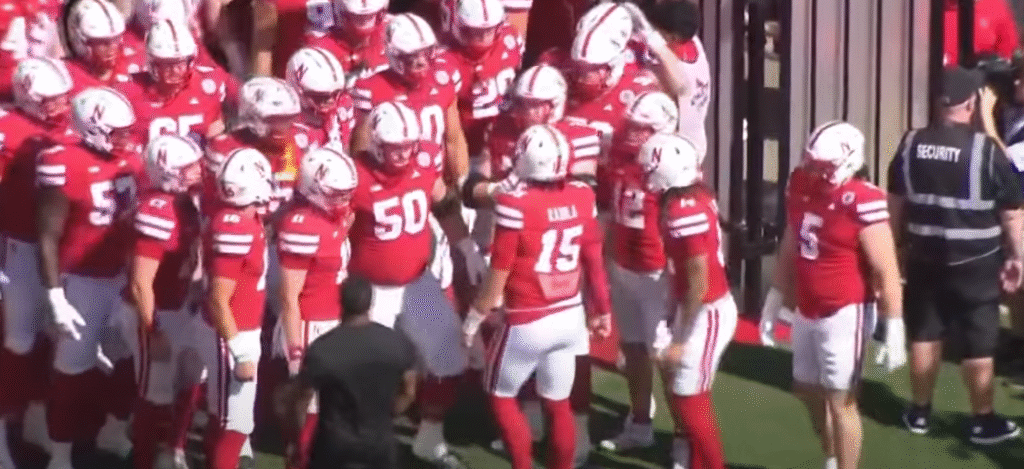In October 2025, Nebraska football made a long-awaited comeback when it was ranked No. 25 in the AP Poll. The return was emotionally significant to a fan base that gauges loyalty by generations rather than seasons. After years of perseverance, disappointment, and reconstruction, this was about validation, not just a ranking.
In September 2024, the Cornhuskers made their final fleeting appearance when they peaked at No. 22 before losing in overtime and falling out. That brief moment of hope was reminiscent of a time when Nebraska dominated news stories rather than chasing them. The team’s name stood for pride, discipline, and consistency for many years. However, after the early 2000s, those connections started to wane and were replaced by seemingly never-ending rebuilding phases.
Nebraska has a particularly lengthy history with the rankings. They have occupied the top spot for an incredible 70 weeks and have been ranked in the AP Poll 48 times in the final standings. They last achieved that top spot on October 22, 2000, right before their reign was abruptly ended by a 31–14 loss to Oklahoma. The program’s identity began to change after that loss, moving from dominance to uncertainty.
Nebraska Cornhuskers Football – Historical and Current Overview
| Category | Details |
|---|---|
| Team Name | Nebraska Cornhuskers |
| University | University of Nebraska–Lincoln |
| Conference | Big Ten Conference |
| Founded | 1890 |
| Home Stadium | Memorial Stadium, Lincoln (Capacity: 81,091) |
| Current Head Coach | Matt Rhule |
| 2025 Season Record | 5–2 Overall, 2–2 Big Ten |
| Last AP Ranking (2025) | No. 25 (October 2025) |
| Previous AP Ranking Before 2025 | No. 22 (September 2024) |
| Last Time Ranked No. 1 | October 22, 2000 (before loss to Oklahoma) |
| National Championships | 5 – (1970, 1971, 1994, 1995, 1997) |
| Conference Titles | 46 (Big Ten, Big 12, Big 8, Big 7, MVIAA) |
| Heisman Trophy Winners | Johnny Rodgers (1972), Mike Rozier (1983), Eric Crouch (2001) |
| Total AP Poll Appearances | 733 Weeks Ranked, 70 Weeks at No. 1 |
| All-Time Record (as of 2025) | 894–407–38 (.684 Win Percentage) |
| Bowl Record | 54 Bowls: 27 Wins, 27 Losses |
| Recent Bowl Appearance | 2024 Pinstripe Bowl – Win |
| Official Reference | Sports Reference – Nebraska Football History |

During the 1990s, Nebraska was a representation of excellence. They won national titles in 1994, 1995, and 1997 under the leadership of renowned coach Tom Osborne, who used strength and accuracy to dominate opponents. Their 1995 squad, which is frequently regarded as one of the best in college football history, established an unassailable standard. The following twenty years, in contrast, were like a journey through fog, seeking a light that never seemed to fully come back.
Even the most devoted have been put to the test in the modern era. The Cornhuskers went through growing pains that seemed to go beyond the field under a rotating staff of coaches, including Solich, Callahan, Pelini, Riley, and Frost. As Nebraska struggled to keep up with the sport’s rapidly changing style, seasons started with hope and ended with frustration. They resembled a legendary rock band adapting to a new musical era in many respects; they were still talented but lacked the harmony that made them unique.
It seemed like a rekindled flame when Mike Riley’s squad momentarily peaked at No. 7 in 2016. However, that moment was swiftly erased following a 62–3 defeat to Ohio State, which revealed just how flimsy Nebraska’s comeback was. Although supporters held onto hope, the idea of long-term relevance kept slipping away.
But under Matt Rhule, the narrative feels noticeably better. His leadership has been extremely successful in changing the team’s identity by prioritizing the basics over flash. Rhule’s strategy is especially novel since it prioritizes culture, development, and discipline over obtaining immediate fame through ostentatious recruitment campaigns. Although subtle, his techniques have been very effective in restoring community and program trust.
It wasn’t by accident that the team was able to return to the Top 25. Nebraska’s 5-1 start in 2025 demonstrated excellent mental toughness and balanced play. They played with purpose, grinding out wins that demonstrated maturity over momentum, even though they didn’t dominate opponents. Rhule’s system was characterized by analysts as “old-school values applied in a new-age structure,” a combination that strikes a powerful chord in a time when authenticity seems especially elusive.
The resurgence of other once-fallen giants is remarkably similar. Consider how Josh Heupel helped Tennessee regain its swagger or how Washington turned into a postseason contender. That pattern—slow, steady, and emotionally genuine—is reflected in Nebraska’s comeback. Supporters are celebrating a foundation rather than a fluke.
Beyond football, this resurgence in the rankings has social and emotional significance. The Nebraska team serves as a cultural hub in addition to being a collegiate program. Lincoln becomes a sea of red on game days, bringing communities, families, and generations together. The team’s recent triumph has been especially good for local spirits, rekindling pride in a state that values tradition just as much as winning.
Younger fans are finally experiencing something of their own, while older fans cherish the Bob Devaney and Tom Osborne eras. The 2025 ranking, in a way, serves as a link between times—a reminder that greatness, even when it is dormant, never really goes away.
Nebraska’s return illustrates resiliency on a larger scale. Periods of reinvention are a part of every great institution, whether it be cultural or athletic. From comeback artists to resurrected brands, the Cornhuskers’ journey reflects tales in both entertainment and business, demonstrating the timeless nature of authenticity when paired with tenacity.
